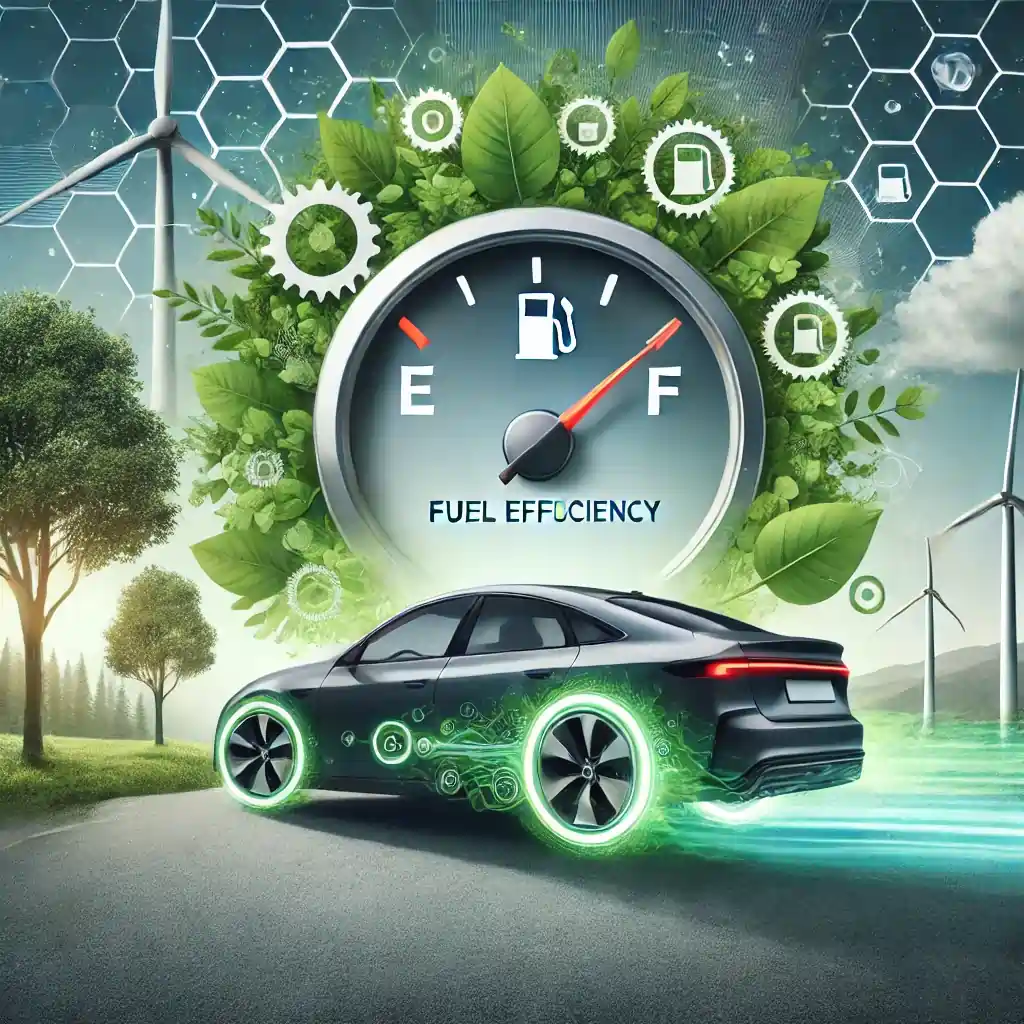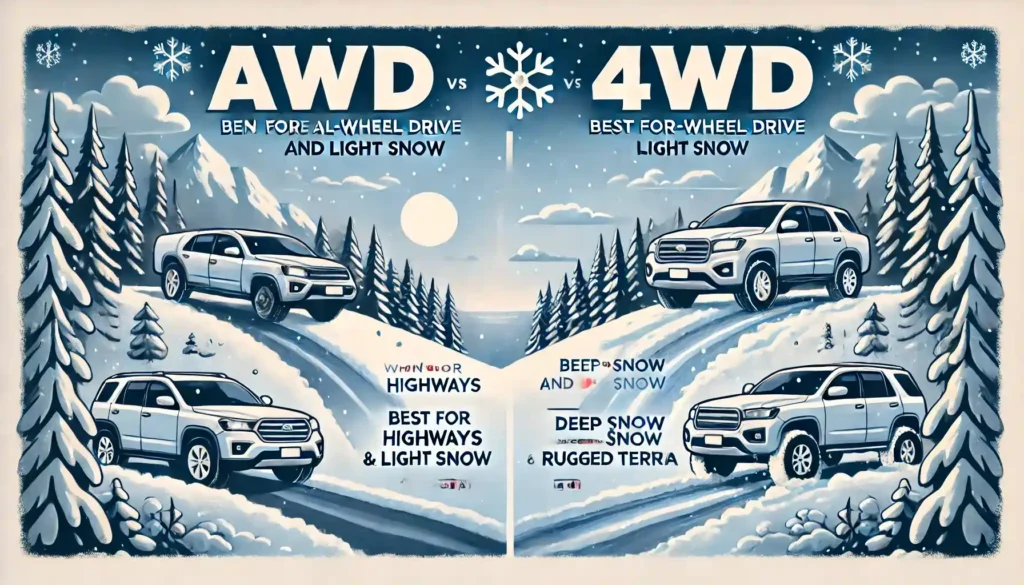When it comes to driving in snow or on slippery roads, the drivetrain system in your vehicle plays a crucial role in ensuring your safety and performance.
Two of the most common systems that help vehicles handle these challenging conditions are All-Wheel Drive (AWD) and Four-Wheel Drive (4WD).
Both systems offer enhanced traction and stability, but they function differently and are suited for different driving needs.
Understanding the difference between AWD and 4WD is essential for anyone who frequently drives in winter conditions or snowy terrain.
The goal of this article is to compare how AWD and 4WD systems perform in snow, helping drivers make an informed decision about which system is better suited to their driving style and winter needs.
When navigating through snowy roads or slippery terrain, it’s important to understand the differences between AWD (All-Wheel Drive) and 4WD (Four-Wheel Drive) systems, as each is designed to meet different driving needs.
AWD is a system where power is automatically distributed to all four wheels of the vehicle, enhancing traction without the need for driver intervention.
This system is ideal for general use and is often found in passenger vehicles like sedans, crossovers, and SUVs. AWD works well in light snow or rain and can handle moderate weather conditions.
It’s a great option for everyday driving in areas with occasional snow or slippery roads.
On the other hand, 4WD is specifically designed for more demanding conditions such as deep snow, mud, or off-road driving. In a 4WD system, power is sent to all four wheels, but the driver has more control over when the system is engaged.
4WD vehicles are equipped with a transfer case that allows the driver to manually select low-range gearing for maximum traction in difficult conditions, such as when you’re stuck in deep snow or off-road terrain.
This section compares AWD and 4WD systems and highlights their strengths based on different snow conditions and driving environments, while also naturally incorporating related terms like snow, slippery terrain, and off-road.
When it comes to driving in snowy conditions, both AWD (All-Wheel Drive) and 4WD (Four-Wheel Drive) systems offer advantages, but they excel in different scenarios.
Understanding how each system performs in snow can help you choose the right one based on your driving needs.

AWD is designed to automatically distribute power to all four wheels when necessary, which makes it an excellent choice for handling light snow and slippery roads.
In moderate snow conditions, AWD can improve traction by sending power to the wheels with the most grip.
However, it’s important to note that AWD does not offer the same level of control or power as 4WD, particularly in deep snow or more severe winter conditions.
Particularly when equipped with a low-range transfer case, is built for more challenging conditions, including deep snow and off-road environments.
4WD systems allow drivers to engage four-wheel drive manually or automatically, providing higher torque to all wheels.
This gives 4WD vehicles better traction and the ability to maintain momentum in thick snow or on uneven, slippery surfaces.
In light snow and slippery roads, AWD is typically sufficient, offering convenience and efficiency.
However, when it comes to deep snow, off-road conditions, or when more control is required, 4WD shines due to its ability to provide higher torque and manual control over power distribution.
Understanding these differences can help you make an informed decision about the best system for navigating winter conditions.
When driving in snow, traction is key to maintaining control of your vehicle. Both AWD (All-Wheel Drive) and 4WD (Four-Wheel Drive) systems are designed to improve traction, but they do so in different ways, making each system better suited for specific conditions.
For additional traction in harsh conditions consider using tire traction aid for light trucks. It will improve the traction in the snow.
AWD is designed to automatically adjust power to all four wheels as needed, making it ideal for roads with light snow or slush.
It is particularly effective on well-maintained roads where the snow is not too deep and the terrain is relatively flat.
The AWD system continuously monitors wheel slip and redirects power to the wheels that have the most traction. This helps prevent slipping on icy or snowy patches, ensuring the vehicle remains stable.
4WD, on the other hand, is specifically designed for challenging conditions like deep snow, ice, and off-road driving.
When engaged, 4WD delivers power to all four wheels simultaneously, which maximizes the grip and traction across all types of snow and difficult terrains.
In situations where the snow is deep or where more torque is required (such as when driving uphill or through thick snow), 4WD outperforms AWD by providing extra traction and control.
This is especially important in conditions where maintaining momentum is critical.
In snowy conditions, AWD is better suited for light snow and slushy roads, offering convenience and stability without the need for manual engagement.
However, for deep snow, ice, or when maximum traction is required (such as on off-road paths), 4WD provides superior handling by offering more power and control over all four wheels, ensuring better grip and preventing slipping in the most challenging conditions.
One of the key considerations when choosing between AWD (All-Wheel Drive) and 4WD (Four-Wheel Drive) is fuel efficiency.

Each system has its impact on a vehicle’s overall fuel economy, which can be a significant factor, especially for drivers who frequently travel long distances or need to conserve fuel in challenging conditions.
AWD systems are typically more fuel-efficient compared to 4WD because they only engage when necessary.
In regular driving conditions, only two wheels (usually the front ones) are powered, which reduces the energy required to move the vehicle.
This means that the engine isn’t constantly working to power all four wheels, resulting in better mileage.
When traction is needed—such as in light snow or rain—the system automatically activates the other wheels, ensuring better control without significant fuel consumption.
On the other hand, 4WD systems are often less fuel-efficient, particularly when they are engaged constantly.
4WD vehicles are designed to provide more torque to all four wheels, which requires more energy, especially when driving on regular roads without the need for extra traction.
While 4WD systems can be turned off when not needed, many off-road or commercial vehicles leave them engaged to ensure maximum traction, which can lead to higher fuel consumption.
This makes 4WD less efficient than AWD, especially for those who drive primarily on paved roads or in mild conditions.
In terms of fuel efficiency, AWD typically has the edge over 4WD due to its on-demand nature, which activates the additional wheels only when needed.
This leads to better mileage and lower fuel consumption, making it a better choice for daily driving or in conditions with light snow or rain.
4WD, while offering superior traction in more extreme conditions, can be less efficient, especially when engaged continuously, making it more suitable for off-road or heavy snow driving where traction is the priority over economy.
When considering AWD (All-Wheel Drive) and 4WD (Four-Wheel Drive) systems, it’s important to evaluate the cost and maintenance required for each.
These systems not only affect the initial purchase price but also the long-term maintenance costs.
AWD systems are generally more affordable than 4WD in terms of both upfront cost and maintenance.
This is because AWD is a simpler system that does not require the additional mechanical components needed for a full-time 4WD setup.
AWD typically uses a more basic mechanism to distribute power to all four wheels only when traction is needed, which results in fewer parts that could potentially need repair or replacement.
On the other hand, 4WD systems come with a higher price tag, both in terms of purchase cost and maintenance.
4WD is designed for more rugged conditions, with a more intricate mechanism to power all four wheels.
This additional complexity requires more specialized components like a transfer case, differentials, and a stronger drive shaft to handle the increased torque and power.
In terms of both initial cost and maintenance, AWD tends to be the more affordable option. It has a lower purchase price and generally requires less maintenance due to its simpler design. But Proper maintenance is key to keeping your AWD or 4WD system functional
This makes it a cost-effective choice for everyday driving in light snow or rain conditions. 4WD, while offering enhanced performance in more extreme conditions, comes with a higher upfront cost and more expensive maintenance and repairs due to its complex system.
For drivers who do not need to frequently navigate off-road or deep snow, the AWD system may be the more budget-friendly choice.
Knowing when to use AWD (All-Wheel Drive) or 4WD (Four-Wheel Drive) in snowy conditions can make a significant difference in your driving experience.

The choice between these two systems depends on the severity of the snow, the type of terrain, and the conditions you’re driving in. Here’s a breakdown of when to use each system:
AWD is ideal for light snow, slush, and icy roads. This system automatically distributes power to all four wheels when needed, making it an excellent option for conditions where you encounter intermittent patches of snow or slippery roads.
AWD can provide added stability and control, but it isn’t designed for deep snow or challenging off-road terrain.
In general, AWD is great for everyday driving in areas that experience occasional snow or icy conditions, where extreme traction and power aren’t required.
4WD is designed for more extreme snow conditions, such as deep snow, off-road driving, or areas where you need maximum traction.
It’s built to tackle rougher terrain and provide higher torque to the wheels, making it a better option for challenging conditions.
In general, 4WD is best suited for drivers who need to traverse difficult, unpredictable terrain or who live in areas where snow accumulates heavily and consistently.
Understanding the capabilities of both systems ensures that you’re prepared for whatever winter conditions come your way, optimizing your safety and driving experience in the snow.
When navigating snowy conditions, it’s important to understand the key differences between AWD (All-Wheel Drive) and 4WD (Four-Wheel Drive) to ensure you’re using the right system for the situation.
AWD is ideal for light snow, slush, and icy roads, as it automatically distributes power to the wheels when needed, offering improved traction without being overly complex.
This system is best suited for everyday winter driving where snow accumulation isn’t heavy or extreme. Studies by NHTSA show that vehicles with AWD perform better on icy roads
On the other hand, 4WD is the go-to option for deep snow, heavy snowstorms, off-road conditions, or challenging terrains.
With its ability to provide higher torque and better grip, it’s essential for handling snowdrifts, unplowed roads, and rough terrains where maximum traction is needed.
Regardless of the system you use, always prioritize safe winter driving practices. Know your vehicle’s capabilities, choose appropriate brakes and best tires for truck, and drive cautiously in snow.
Understanding when and how to engage your AWD or 4WD system will not only improve your performance in winter conditions but also enhance safety on the road.
Always ensure your vehicle is equipped for the conditions you’ll encounter, and take precautions to avoid risky situations.
